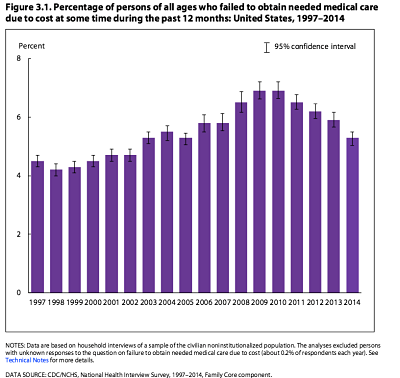Article
Care Costs Stopping Fewer Americans from Seeking Treatment
Author(s):
Treatments skipped due to cost are at their lowest percentage since 1999.
Treatments skipped due to cost are at their lowest percentage since 1999.
In its latest National Health Interview Survey, the US Centers for Disease Control and Prevention (CDC) found that only 1 in 20 Americans (4.4%) reported forgoing medical treatment due to cost. In 2009 and 2010, that figure was nearly 7%.

While the CDC survey did not delve into why fewer Americans are skipping treatment over cost concerns, the downward shift coincides with 2 major changes in the US health care system: the formation of government health insurance exchanges that sell private insurance to those who do not receive employer-based coverage, and the expansion of Medicaid coverage in more than half of US states.
This expanded insurance coverage has led to greater use of medical services and prescription purchases, suggesting that the Affordable Care Act (ACA) can be credited for the marked decrease in the number of patients having problems accessing and paying for care.
For instance, a recent Deloitte survey found that ACA exchanges are improving patient access to preventative care. Almost 66% of public health insurance exchange customers reported using their plans to seek services and purchase medications, with 75% saying they would not have done so without the coverage.
Although the data from both the CDC and Deloitte appear promising, affordability remains a concern for many Americans with and without health insurance.
When broken down by patient age, the CDC data show that adults who are too young for Medicare forgo care. In the survey, 6.1% of those adults reported not seeking care, while just 2.4% of adults over 64 reported doing so.
Among those who purchased insurance on public health insurance exchanges, the Deloitte survey found that 1 in 3 enrollees have had trouble paying for out-of-pocket health care expenses, and just 16% feel financially prepared to handle future health costs.
For populations that are more likely to avoid treatment due to cost, pharmacists have an opportunity to educate patients about the potential future costs they may incur if they don’t maintain their prescribed health regimens. In this way, pharmacists can frame care costs as an investment.
“Pharmacists provide a friendly and convenient venue for many patients who might otherwise have trouble getting recommended care,” Jared Fox, PhD, of the CDC’s Office of the Associate Director for Policy recently told Pharmacy Times. “If pharmacists are able to provide evidence-based preventive services to patients, that could help to increase the number of people receiving recommended preventive care.”





